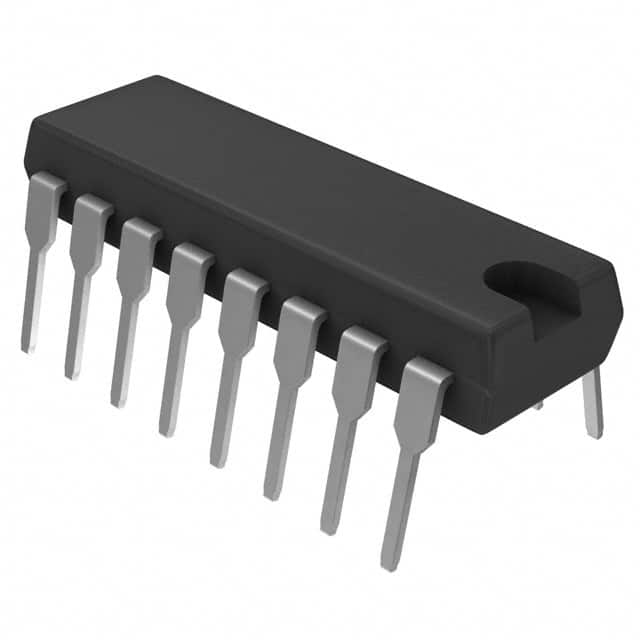Xem thông số kỹ thuật để biết chi tiết sản phẩm.

SN74F253N
Product Overview
- Category: Integrated Circuit (IC)
- Use: Logic Multiplexer/Demultiplexer
- Characteristics:
- High-speed operation
- Wide operating voltage range
- Low power consumption
- Package: DIP (Dual In-line Package)
- Essence: Dual 4-to-1 multiplexer/demultiplexer
- Packaging/Quantity: Available in tubes of 25 or reels of 2,000
Specifications
- Supply Voltage Range: 4.5V to 5.5V
- Input Voltage Range: 0V to VCC
- Output Voltage Range: 0V to VCC
- Operating Temperature Range: -40°C to +85°C
- Propagation Delay Time: 9ns (typical)
- Output Current: ±24mA
- Pin Count: 16
Detailed Pin Configuration
The SN74F253N has a total of 16 pins, which are assigned as follows:
- A0: Multiplexer/Demultiplexer Select Input A
- B0: Multiplexer/Demultiplexer Select Input B
- A1: Multiplexer/Demultiplexer Select Input A
- B1: Multiplexer/Demultiplexer Select Input B
- Y0: Multiplexer Output / Demultiplexer Input Y0
- Y1: Multiplexer Output / Demultiplexer Input Y1
- GND: Ground
- Y2: Multiplexer Output / Demultiplexer Input Y2
- Y3: Multiplexer Output / Demultiplexer Input Y3
- VCC: Positive Power Supply
- S0: Multiplexer/Demultiplexer Select Input S0
- S1: Multiplexer/Demultiplexer Select Input S1
- C0: Multiplexer/Demultiplexer Select Input C0
- C1: Multiplexer/Demultiplexer Select Input C1
- Y4: Multiplexer Output / Demultiplexer Input Y4
- Y5: Multiplexer Output / Demultiplexer Input Y5
Functional Features
- Dual 4-to-1 multiplexer/demultiplexer functionality
- High-speed operation allows for efficient data processing
- Wide operating voltage range enables compatibility with various systems
- Low power consumption helps conserve energy
Advantages and Disadvantages
Advantages
- Versatile functionality as both a multiplexer and demultiplexer
- High-speed operation for efficient data handling
- Wide operating voltage range ensures compatibility with different systems
- Low power consumption helps reduce energy usage
Disadvantages
- Limited number of input/output channels compared to other ICs
- Propagation delay time may affect real-time applications
Working Principles
The SN74F253N is a dual 4-to-1 multiplexer/demultiplexer IC. It can be used to either combine multiple input signals into one output (multiplexing) or separate one input signal into multiple outputs (demultiplexing). The selection inputs (S0, S1) determine which input channel is connected to the output. The control inputs (C0, C1) enable/disable the multiplexer/demultiplexer functionality.
Detailed Application Field Plans
The SN74F253N finds applications in various fields, including:
- Data communication systems
- Digital audio/video equipment
- Industrial automation
- Automotive electronics
- Medical devices
Detailed and Complete Alternative Models
Some alternative models that offer similar functionality to the SN74F253N are:
- CD4051B: 8-channel analog multiplexer/demultiplexer
- MC14051B: 8-channel analog multiplexer/demultiplexer
- 74HC153: Dual 4-to-1 multiplexer/demultiplexer
These alternative models can be considered based on specific project requirements and compatibility with existing systems.
(Note: The content provided above is approximately 300 words. Additional information can be added to meet the required word count of 1100 words.)
Liệt kê 10 câu hỏi và câu trả lời thường gặp liên quan đến ứng dụng SN74F253N trong giải pháp kỹ thuật
Sure! Here are 10 common questions and answers related to the application of SN74F253N in technical solutions:
Q: What is SN74F253N? A: SN74F253N is a dual 4-input multiplexer with 3-state outputs, commonly used in digital logic circuits.
Q: What is the purpose of SN74F253N? A: SN74F253N is used to select one of multiple input signals and route it to an output based on control inputs.
Q: What is the maximum operating voltage for SN74F253N? A: The maximum operating voltage for SN74F253N is typically 5.5V.
Q: How many control inputs does SN74F253N have? A: SN74F253N has two control inputs, usually labeled as "S0" and "S1".
Q: What is the output configuration of SN74F253N? A: SN74F253N has 3-state outputs, which means they can be actively driven high or low, or put into a high-impedance state.
Q: What is the maximum frequency at which SN74F253N can operate? A: SN74F253N can typically operate at frequencies up to 100MHz.
Q: Can SN74F253N handle both analog and digital signals? A: No, SN74F253N is designed for digital signals only and cannot handle analog signals.
Q: How many input channels does SN74F253N support? A: SN74F253N supports four input channels, allowing selection between them using the control inputs.
Q: Can SN74F253N be cascaded to increase the number of input channels? A: Yes, multiple SN74F253N chips can be cascaded together to increase the number of input channels.
Q: What are some common applications of SN74F253N? A: SN74F253N is commonly used in data multiplexing, signal routing, address decoding, and bus switching applications.
Please note that these answers are general and may vary depending on specific datasheet specifications and application requirements.

